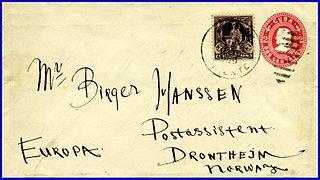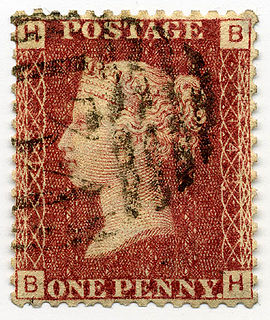
Philately is the study of stamps and postal history and other related items. It also refers to the collection, appreciation and research activities on stamps and other philatelic products. Philately involves more than just stamp collecting, which does not necessarily involve the study of stamps. It is possible to be a philatelist without owning any stamps. For instance, the stamps being studied may be very rare, or reside only in museums.
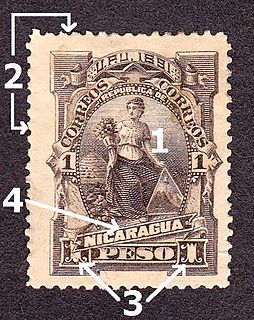
A postage stamp is a small piece of paper issued by a post office, postal administration, or other authorized vendors to customers who pay postage, who then affix the stamp to the face or address-side of any item of mail—an envelope or other postal cover —that they wish to send. The item is then processed by the postal system, where a postmark or cancellation mark—in modern usage indicating date and point of origin of mailing—is applied to the stamp and its left and right sides to prevent its reuse. The item is then delivered to its addressee.
A first day of issue cover or first day cover (FDC) is a postage stamp on a cover, postal card or stamped envelope franked on the first day the issue is authorized for use within the country or territory of the stamp-issuing authority. Sometimes the issue is made from a temporary or permanent foreign or overseas office. Covers that are postmarked at sea or their next port of call will carry a Paquebot postmark. There will usually be a first day of issue postmark, frequently a pictorial cancellation, indicating the city and date where the item was first issued, and "first day of issue" is often used to refer to this postmark. Depending on the policy of the nation issuing the stamp, official first day postmarks may sometimes be applied to covers weeks or months after the date indicated.

An envelope is a common packaging item, usually made of thin, flat material. It is designed to contain a flat object, such as a letter or card.
East Africa and Uganda Protectorates was the name used by the combined postal service of the British protectorates, British East Africa and Uganda, between 1 April 1903 and 22 July 1920.

A piece of postal stationery is a stationery item, such as a stamped envelope, letter sheet, postal card, lettercard, aerogram or wrapper, with an imprinted stamp or inscription indicating that a specific rate of postage or related service has been prepaid. It does not, however, include any postcard without a pre-printed stamp.

A commemorative stamp is a postage stamp, often issued on a significant date such as an anniversary, to honor or commemorate a place, event, person, or object. The subject of the commemorative stamp is usually spelled out in print, unlike definitive stamps which normally depict the subject along with the denomination and country name only. Many postal services issue several commemorative stamps each year, sometimes holding first day of issue ceremonies at locations connected with the subjects. Commemorative stamps can be used alongside ordinary stamps. Unlike definitive stamps that are often reprinted and sold over a prolonged period of time for general usage, commemorative stamps are usually printed in limited quantities and sold for a much shorter period of time, usually until supplies run out.

Mulready stationery describes the postal stationery letter sheets and envelopes that were introduced as part of the British Post Office postal reforms of 1840. They went on sale on 1 May 1840, and were valid for use from 6 May. The Mulready name arises from the fact that William Mulready, a well-known artist of the time, was commissioned to illustrate the part of the letter sheets and envelopes which corresponded with the face area.

In philately, a cachet is a printed or stamped design or inscription, other than a cancellation or pre-printed postage, on an envelope, postcard, or postal card to commemorate a postal or philatelic event. There are official and private cachets. They commemorate everything from the first flight on a particular route, to the Super Bowl. Cachets are also frequently made, either by private companies or a government, for first day of issue stamp events or "second-day" stamp events. They are often present on event covers.

In philately, the term cover pertains to the outside of an envelope or package with an address, typically with postage stamps that have been cancelled and is a term generally used among stamp and postal history collectors. The term does not include the contents of the letter or package, although they may add interest to the item if still present. Cover collecting plays an important role in postal history as many covers bear stamps, postmarks and other markings along with names and addresses all of which help to place a cover at a given time and place in history.

The postage stamps and postal system of the Confederate States of America carried the mail of the Confederacy for a brief period in American history. Early in 1861 when South Carolina no longer considered itself part of the Union and demanded that the U.S. Army abandon Fort Sumter, plans for a Confederate postal system were already underway. Indeed, the Confederate Post office was established on February 21, 1861; and it was not until April 12 that the American Civil War officially began, when the Confederate Army fired upon US soldiers who had refused to abandon the fort. However, the United States Post Office Department continued to handle the mail of the seceded states as usual during the first weeks of the war. It was not until June 1 that the Confederate Post office took over collection and delivery, now faced with the task of providing postage stamps and mail services for its citizens.

In philately, a cut square is an imprinted stamp cut from an item of postal stationery such as a stamped envelope, postal card, letter sheet, letter card, aerogram or wrapper in a square or rectangular shape. An alternative use of the term is simply any stamp, from sheets or postal stationery, cut in a square or rectangular shape and not cut to shape.

A cancelled to order postage stamp is a stamp the issuing postal service has cancelled, but has not traveled through the post, but instead get handed back to a stamp collector or dealer. They can come from withdrawn stocks of stamps cancelled in sheets and sold as remainders or from new sheets for sale at reduced rates to the stamp trade. Postal services of various countries do this in response to collector demand, or to preclude stamps issued for the collector market being used on mail. Some of the history of CTOs is from stamps being given to collectors on an approval basis, in person or through mailings; the first CTOs began in the late 19th century.
This is a survey of the postage stamps and postal history of British East Africa.
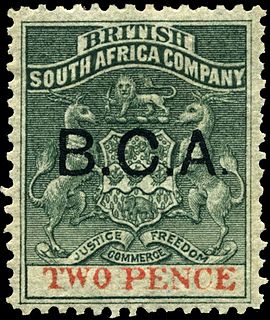
The British Central Africa Protectorate existed in the area of present-day Malawi between 1891 and 1907.

The Facing Identification Mark, or FIM, is a bar code designed by the United States Postal Service to assist in the automated processing of mail. The FIM is a set of vertical bars printed on the envelope or postcard near the upper edge, just to the left of the postage area. The FIM is intended for use primarily on preprinted envelopes and postcards and is applied by the company printing the envelopes or postcards, not by the USPS.

Official mail is mail sent from, or by, an authorized department of government, governmental agency or international organization and normally has some indication that it is official; a certifying cachet, return address or other means of identity, indicating its user. In some countries, postage stamps have been issued specifically for official mail.

In philately, an imprinted stamp is a stamp printed onto a piece of postal stationery such as a stamped envelope, postal card, letter sheet, letter card, aerogram or wrapper. The printing may be flat upon the surface of the paper, or embossed with a raised relief. An imprinted stamp is also known as unadhesive stamp or indicium.
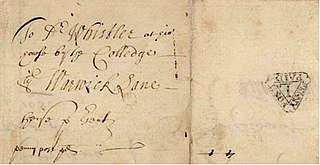
The Fletcher Collection is Hugh Greenwell Fletcher's lifetime philatelic collection of British postage stamps and British stamps used abroad including overprints and non-stamp items such as postal stationery. On his death in 1968, the collection was bequeathed to the Bruce Castle Museum in Tottenham, once the home of Sir Rowland Hill. The collection was donated to the British Library in 1989.


